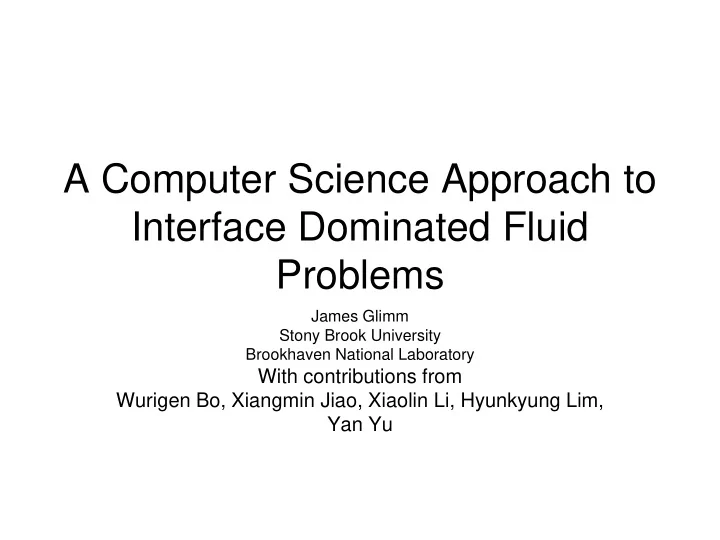

A Computer Science Approach to Interface Dominated Fluid Problems James Glimm Stony Brook University Brookhaven National Laboratory With contributions from Wurigen Bo, Xiangmin Jiao, Xiaolin Li, Hyunkyung Lim, Yan Yu
The physics problem • Turbulent flows with multifluid interfaces – Acceleration driven mixing • Inertial confinement fusion • Target design for high energy particle accelerators – Rapidly stirred flows • Chemical processing (e.g. fuel separation for spent nuclear reactor rods) – Turbulent combustion • Combustion in the engine of a Scramjet (M = 7 experimental aircraft)
The Applied Mathematics Problem • Numerical methods for interfaces are usually low order and inaccurate. • For problems dominated by interfaces or by approximate interfaces (steep gradients), the dominant error occurs at or near the interface • Interface methods help a little • Good interface methods help a lot • Also need help from physics/engineering: models for unresolved turbulence below the grid scale.
The Program: Construct good interface methods, Couple to good subgrid scale models • This presentation: good interface methods • This is a Computer Science problem • Essential difficulties – Code organization to describe a general interface – Robust handling of intersection detection and recovery from self intersections – Higher order methods
The Solution • Code organization: C++ and other modern paradigms are sufficient • Self intersections: not too hard. – Hash list of triangles in blocks, linear algebra to detect collisions. O(n) algorithm, but still expensive. • Intersection recovery – Extreme reliability is needed • Simulations on up to 8K cores, running for week+ time frames, require an extremely low error rate. • Higher order accuracy – Seldom attempted; partially implemented in our programs
Intersection Recovery • Combine a low order recovery algorithm with a more accurate geometry and propagation algorithm – Interface defined as triangulated surface • Accurate, but not robust for intersection resolution • Retriangulate periodically to assure uniform size and aspect ratios for triangles – Interface reconstructed from intersections with cell block edges • Typical of computer graphics routines • Robust and fast but not very accurate • First is grid free, second is grid based
Hybrid solution • Locally Grid Based (LGB) – Has high accuracy of grid free – Has robustness of grid based – Main idea: put intersecting region of interface in a rectangular solid formed out of mesh blocks • Use grid free outside • Use grid based inside • Inside region is small, integrated over space and time, so accuracy is dominated by grid free part (high) • All problems are inside, where robust algorithm is used, so LGB is robust – If several intersections, put such a bounding box outside of each. – If too many intersections and too much overlap of bounding boxes, restart time step with a smaller Delta t. – Existing time step restriction makes above reduction of time step unlikely
First Problem • There is a gap between inside and outside surface. This must be filled in. • Typically edge of inner and outer surface is a curve. • Trace around points of inner and outer edge curves, adding one bond at a time to join the two.
Second Problem • For parallel computation, • Determination of inner and outer surface curve to be communicated between processors if necessory • Choices of bonds to fill in gaps also to be communicated • Impractical levels of communication
Solution of Second Problem • If possible, increase the buffer size of duplicate shared information at the boundary of parallel processing domains • If not possible, move entire inside-outside geometry to a single processor – Solve locally – Communicate solution to location needed • Solution is currently under test with 8K cores running at ANL, for week+ simulation.
The Payoff: Quality Solutions • Rayleigh-Taylor fluid mixing – Controversial problem with a 60 year history, and generally persistent failure to achieve simulation agreement with experiment. – Heavy fluid (water) over light fluid (air), accelerated (by gravity): flat surface is unstable • Bubbles of light fluid penetrate into the heavy fluid • Distance h = bubble penetration distance • Compared to a scaled acceleration distance Agt 2 – Define alpha = h/Agt 2
Two comparisons: experiments vs. simulations Simulations by Hunkyung Lim and Tulin Kaman. Performed on NYBlue.
Summary Results • Six simulations compared to experiments – Nearly perfect agreement with experiment in all cases – Multiple physical processes and parameters • Immiscible – Variable surface tension (Weber number) • Miscible – variable rates of mass diffusion (Schmidt number) • High and moderate Reynolds number
Two Phase Rotating Fluids Couette Flow
Recommend
More recommend